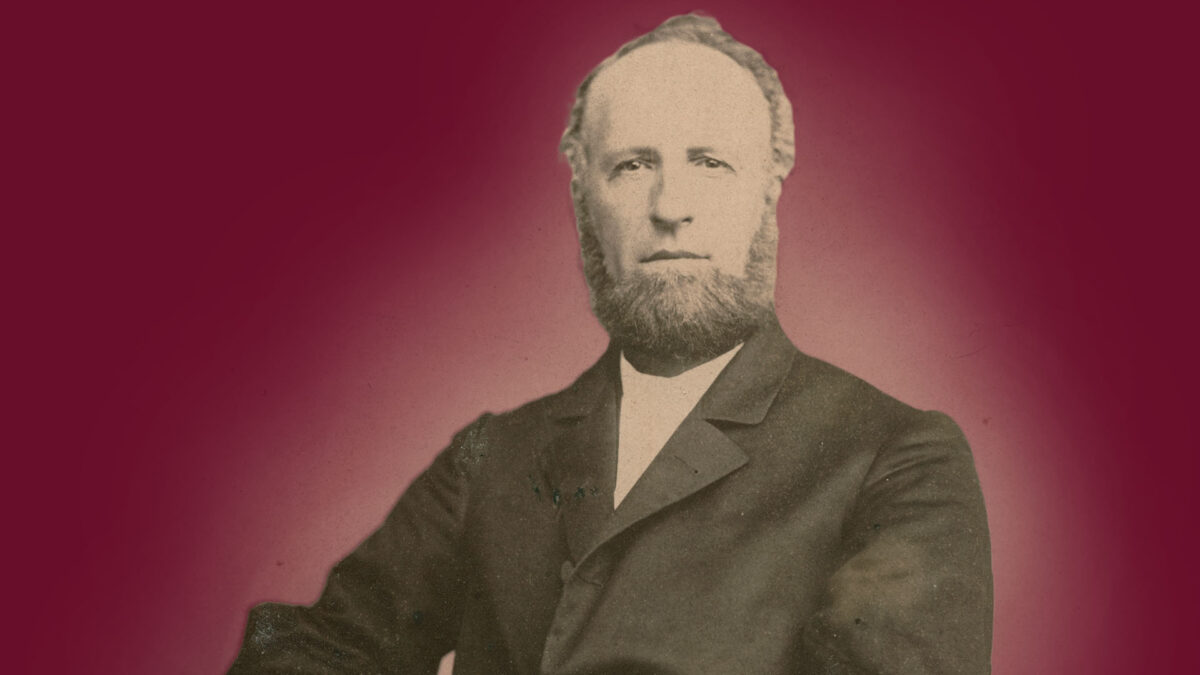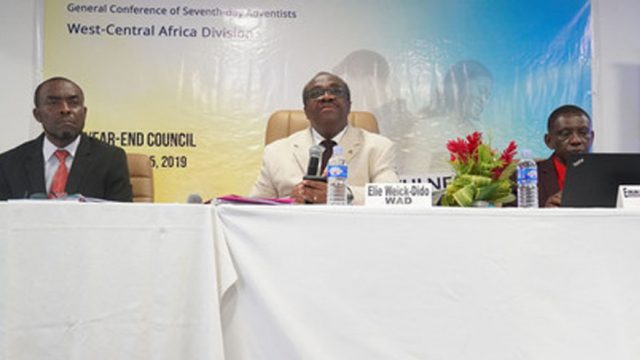A Man of Prayer and Action

The Seventh-day Adventist movement began under divine guidance, with James White, Ellen White, and Joseph Bates as its primary leaders. James was the main leader and organizer of the emerging church during both its embryonic and growing stages. He stood side by side with his wife as a “faithful warrior” for 36 years “in the battle for truth.”¹ This year marks the 200th anniversary of James’s birth. His story must be remembered.
W. C. White described his father as a man who “prayed with earnestness and with solemn reverence.”² James’s niece Lillian Belden remembered him often going away by himself and praying in “lonely attics or haylofts” when the “sun was dropping down . . . wringing his hands,”³ pleading with God until he received an answer. James considered prayer to be a sacred duty; however, it “was never designed to take the place of justice, benevolence, true repentance, and mercy.”⁴ To him, prayer and action went hand in hand.
EARLY DAYS
James was born on August 4, 1821, in Palmyra, Maine. Raised by active and devout Christian parents, he learned to be a man of prayer and action. He experienced true conversion when he was 13. Feeling “pressed with the weight” of his sins, he cried to Jesus for forgiveness and acceptance,⁵ and was later baptized into the Christian Connexion Church.
James was unable to go to school during his childhood because of cross-eyed vision and a digestive disorder. When he was 16, his physical impairments resolved. He began a brief course of study and, three years later, achieved his academic dream of becoming a teacher. Unfortunately, he traded time with God for his studies and lost the taste for Bible study.
During that time William Miller’s clear arguments and powerful exhortations convinced James to go back to the Bible. James’s hope of secular prosperity was replaced by spiritual convictions, and he began working enthusiastically for the Millerite cause.⁶ James was changed from a secular man to a spiritual leader. He identified as a Christian Connexion minister during his Millerite preaching in the fall of 1842.
BEGINNING OF SABBATARIAN ADVENTISM
After the 1844 disappointment, James did not abandon his faith in the soon coming of Jesus, but immersed himself in Bible study. Along with other dedicated followers of the Bible, he helped to organize the Seventh-day Adventist Church in 1863. As a man with “a burning zeal in activity, in harmony with an overmastering faith,”⁷ James dedicated his life to preaching the Adventist message.
On August 30, 1846, James married Ellen Harmon. The beginnings of their married life were characterized by poverty and poor health. One time, to make enough money to support his family and attend his first Sabbatarian conference in Rocky Hill, Connecticut, James went into the woods to chop cordwood. He developed severe pain and was unable to sleep. Prayers arose night after night to relieve James’s pain and give him strength.⁸
That summer the Whites were invited to attend meetings in western New York. James “took a large job of mowing, and when fainting beneath the noonday sun,” he “would bow before God” and “call upon him for strength” to be refreshed and mow on again.⁹ After five weeks he earned enough to attend the conference. Thus, in action and prayer, James found strength and relief.
James and Ellen were significant sources of encouragement to each other through 35 years of shared joys, losses, extensive travels, and ministry. Their letters reveal the very real nature of their marriage. When a disheartened James said, “Wife, it is of no use to try to struggle on any longer,” Ellen was there to encourage him.¹⁰ When Ellen questioned the ways of God, James was there to utter, “Hush, the Lord has not forsaken us. He gives us enough for our present wants. Jesus fared no better.”¹¹
JAMES AND THE CAUSE
James was an enthusiastic and industrious man who did not give up easily. He was a prolific writer, initiated the first regular Seventh-day Adventist periodical in 1849 (now Adventist Review), and founded the Review and Herald and Pacific Press publishing houses. He considered the publishing ministry his “burden” and “work.”¹² His fundraising and business skills assisted church institutions facing heavy financial difficulties. He declined the office of president of the newly established General Conference in 1863, although he later served several terms as president, for a total of 10 years. He had an eye to find and connect talented and consecrated people, such as Annie and Uriah Smith, John Andrews, John Loughborough, and others, to the work of the church. His entire adult life was interwoven with the Adventist cause and its progress.
STROKES AND LAST YEARS
James engaged himself in “continued physical and mental strain, without the least relaxation from labor for more than ten years,” resulting in tragic consequences.¹³ On August 16, 1865, he suffered the first of a series of strokes. The effects of these strokes afflicted him for the rest of his life.
While living in Greenville, Michigan, and experiencing difficulty in performing mental or physical labor, the Whites united more ardently in constant prayer. “My husband and I,” wrote Ellen, “visited the grove frequently and pleaded with God for health and strength to continue to labor in His cause.”¹⁴
On August 6, 1881, James passed away. His last days were spent in intense prayer. “About two weeks before his death,” Ellen penned, “my husband often asked me to accompany him to the grove, near our house, to engage with him in prayer. These were precious seasons.” They confessed to each other and supplicated “for the mercy and blessing of God.”¹⁵ James also confessed to others and asked for the forgiveness of his brethren, recognizing his fallibility, limitations, and frailty.
Ellen deeply missed James and their prayer moments. She wrote, “How I miss him! . . . How I long to hear his prayers blending with my prayers for light and guidance, for wisdom to know how to plan and lay out the work!”¹⁶ “The best way in which I and my children can honor the memory of him who has fallen is to take the work where he left it, and in the strength of Jesus carry it forward to completion.”¹⁷
¹ E. G. White, “Notes of Travel: The Cause in Vermont,” Review and Herald, Nov. 20, 1883.
² William C. White, “Sketches and Memories of James and Ellen G. White: Early Memories of Our First Home,” Review and Herald, Feb. 13, 1936.
³ Mrs. H. J. Gilbert (Lillie Belden-Gilbert) to M. E. Olsen, Jan. 19, 1913, Ellen G. White Estate correspondence file, in James R. Nix, “Our Praying Pioneers,” Adventist World, NAD edition, October 2011.
⁴ James White, An Earnest Appeal ([Battle Creek, Mich.]: 1874), p. 40.
⁵ James White, “That Sweet Morning,” Youth’s Instructor, February 1854.
⁶ James White, Life Incidents (Battle Creek, Mich.: Seventh-day Adventist Pub. Assn., 1868), pp. 65-72..
⁷ William C. White, “Sketches and Memories of James and Ellen G. White: The Man Who Couldn’t Wait,” Review and Herald, Feb. 28, 1935.
⁸ Ellen G. White, Spiritual Gifts (Battle Creek, Mich.: Seventh-day Adventist Pub. Assn., 1860), vol. 2, p. 88.
⁹ James White, Life Incidents, p. 274; E. G. White, Spiritual Gifts, vol. 2, p. 94.
¹⁰ Ellen G. White, Testimonies for the Church (Mountain View, Calif.: Pacific Press Pub. Assn., 1948), vol. 1, p. 89.
¹¹ Ellen G. White manuscript 19, 1885, in Ellen G. White, Manuscript Releases (Silver Spring, Md.: Ellen G. White Estate, 1990), vol. 6, pp. 131, 132.
¹² James White, “The Power of the Press,” Review and Herald, July 19, 1881.
¹³ James White, “The Future,” Review and Herald, Jan. 10, 1871.
¹⁴ Ellen G. White manuscript 6, 1868.
¹⁵ Ellen G. White, “A Sketch of Experience,” In Memoriam: A Sketch of the Last Sickness and Death of Elder James White (Battle Creek, Mich.: Review and Herald Press, 1881), pp. 46, 47.
¹⁶ Ellen G. White letter 196, 1899, in Ellen G. White, Selected Messages (Washington, D.C.: Review and Herald Pub. Assn., 1958, 1980), book 2, p. 259.
¹⁷ E. G. White, “A Sketch of Experience,” In Memoriam, p. 55; E. G. White, Testimonies, vol. 1, p. 111.








